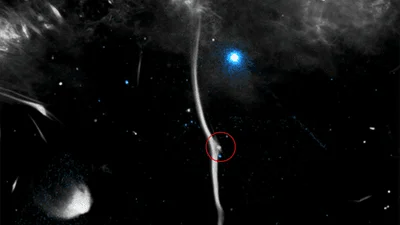
Cosmic Collision: NASA Detects Fracture in Milky Way’s ‘Snake’ Filament, Blaming High-Speed Pulsar
In a stellar diagnosis, NASA's Chandra X-ray Observatory has identified a 'fracture' in a massive structure within our galaxy, the Milky Way. This cosmic 'bone,' officially known as G359.13142-0.20005 (or G359.13), nicknamed the "Snake", is a galactic center filament stretching about 230 light-years long. The culprit behind this interstellar break? A high-speed collision with a pulsar, a rapidly spinning neutron star.
The discovery, detailed in the May 2024 issue of the Monthly Notices of the Royal Astronomical Society, combines data from Chandra X-ray Observatory, the MeerKAT radio array in South Africa, and the National Science Foundation’s Very Large Array in New Mexico. This collaborative effort revealed a break in the filament's structure, sparking intrigue among astronomers.

"The Snake is a remarkable Galactic center radio filament with a morphology characterized by two kinks along its ~ 20 arcmin extent," the researchers explained. These "kinks" indicate points where the filament deviates most significantly from the linear, magnetized structure.
According to scientists, the pulsar slammed into G359.13 at an estimated speed of one to two million miles per hour (1.6 to 3.2 million km per hour). This incredibly forceful impact distorted the filament's magnetic field, warping the radio signal and causing the observed fracture. The collision also injected relativistic particles, accelerating electrons and positrons to high energies, resulting in the detected X-ray emissions.
The team identified an X-ray and radio source mirroring the location of the break. Their findings suggest the high-speed pulsar acted like a punch through the galactic snake, disrupting its structure, and creating X-ray emissions.
At 230 light-years in length and located 26,000 light-years from Earth, "the Snake" is one of the brightest and longest of these structures in the Milky Way. While the break isn't exactly a bone fracture requiring a cast, scientists are intensely studying the long-term effects of this cosmic collision and seeking further observations to better understand the interaction between pulsars and galactic filaments.
This monumental clash, however distant, prompts profound questions about the forces that shape our galaxy. How do these energetic collisions influence the evolution of galactic structures? What other secrets might the "Snake" hold?
Leave your thoughts and share your perspective in the comments below!